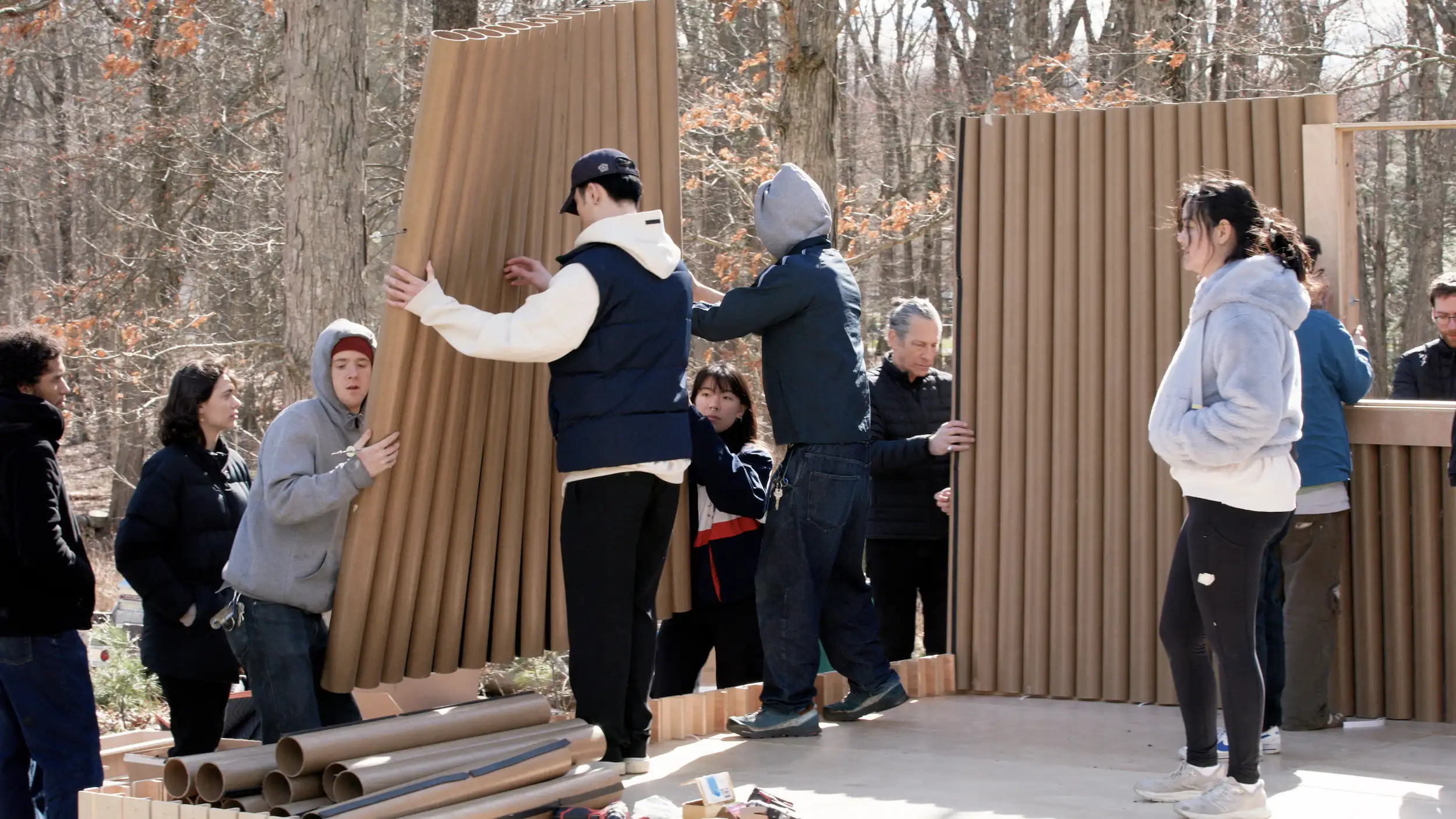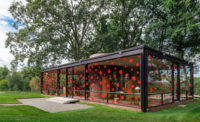Shigeru Ban’s Paper Log House Meets Glass—and Brick—at Historic Philip Johnson Estate

Architects & Firms
The freshly launched 2024 visitor season at Philip Johnson’s Glass House is a significant one. Not only does the National Trust for Historic Preservation–owned house museum’s namesake dwelling turn 75, Johnson’s adjacent guest cottage on the 49-acre estate, Brick House, has reopened following an extensive restoration project. Completed in 1949 just months before the Glass House, the heavily water-damaged Brick House had been closed to the public since 2008.
What’s more, there’s also a new arrival to the bucolic Glass House campus, creating the trifecta of glass, brick, and … paper.
On public view for the first time in the U.S. in six years on the Glass House grounds in New Canaan, Conneticut, is the latest iteration of Shigeru Ban’s Paper Log House. The Japanese architect’s highly adaptable, low-cost emergency shelter, which has been erected in locales across the globe ravaged by conflict and natural calamities, will remain on view in the south meadow just below the Glass House through the end of the visitor season in mid-December. The installation anchors Shigeru Ban: Paper Log House, a didactic exhibition on the Pritzker Prize–winner’s economical and context-sensitive take on humanitarian relief architecture. Presenting the work of Shigeru Ban Architects (SBA) and the firm’s nonprofit emergency-response arm, the Voluntary Action Network (VAN), the show features a time-lapse film documenting the assembly of the Paper Log House at the Glass House as well as information on other humanitarian efforts by SBA and VAN, including the still-standing Cardboard Cathedral (2013) in Christchurch, New Zealand, and a Paper Log House built in Maui following the island’s catastrophic 2023 wildfires. Also featured is a rare non-paper-tube project now in progress: a mass timber hospital in Lviv, Ukraine. The small exhibition is staged at Da Monsta, a Deconstructivist pavilion added in 1995 to the New Canaan compound shared by Johnson and his longtime partner, the art curator David Whitney.

Paper Log House at the Glass House. Photo by Michael Biondo, courtesy the Glass House
Just down the hill from Da Monsta and the estate’s main entrance gate is the Paper Log House. Assembled atop a compacted gravel pad overlooking the Glass House’s Pavilion on the Pond (1962), the 185-square-foot structure was realized as a collaborative project between the New York office of SBA, led by the firm’s managing partner for North American projects Dean Maltz, and the Irwin S. Chanin School of Architecture at the Cooper Union, where both Ban and Maltz studied architecture. Work kicked off at Cooper Union in February, when 39 students enrolled in the university’s Construction Technology course began preparing and fabricating the Paper Log House’s core components over a 5-week span: 156 marine varnish–treated cardboard tubes, plywood flooring, a coated canvas roof, and 39 sandbag-stuffed milk crates that serve as the temporary enclosure’s foundation.


Photos by Michael Biondo, courtesy the Glass House
“It’s a period of architecture that we’re in,” said Maltz during a recent tour of the site, referencing buildings designed in response to natural disasters and the devastating impacts of climate change. “A lot of students are embracing helping others.”
Following a dress rehearsal in which the structure was erected and then disassembled in Cooper Union’s Great Hall, a team of 17 Cooper Union students, faculty, and SBA staff led by Maltz transported the materials from New York City to New Canaan and assembled the 13.5-foot by 13.5-foot shelter at the Glass House site in late March. The final assembly process took 15 hours spread over two days, demonstrating the rapid, low-waste nature of Ban’s Paper Tube House design concept.




Fabrication and assembly video stills. Photos by Hudson Lines
“I believe Johnson would have really embraced Paper Log House,” said Maltz. “When you look at all the different buildings built here over time, each one is representative of a different style of architecture, and you can also see that in his practice.”
“In today’s world, where we have so much natural disaster—and there’s the need within architecture to give back and help others.” Maltz adds.
Of course, assembling a modest, temporary shelter from zip ties and cardboard tubes on the grounds of a historic Modernist estate in one of the country’s wealthiest zip codes doesn’t take on the same urgency of Ban’s non-exhibition Paper Log Houses—the ones built to house those displaced by earthquakes and wildfires. As a press release details, there were challenges, however, during the assembly process, including cold temps and blustery wind.

The Glass House overlooks the Paper Log House. Photo by Michael Biondo, courtesy the Glass House
“Visitors will be able to consider the value of both historic preservation and permanence in glass and brick juxtaposed with temporary, recyclable, and movable structures made of paper and cardboard,” said the Glass House curators of the new seasonal addition to the site. “In today’s world of mass migration, due to conflict and natural disasters, the public can see a simple solution for aiding those in need of immediate shelter.”
Shigeru Ban: Paper Log House is on view at the Glass House through December 15. Visitor information can be found here.




-min.jpg?height=200&t=1680140864&width=200)